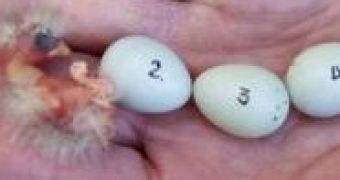A new study by scientists at the University of Arizona found that female house finches (Carpodacus maximus) can change their hormonal makeup to ensure males hatch later, grow faster and spend less time in the nest than their sisters.
When mites invade in a house finch's nest, she protects her sons from the blood-suckers by laying male eggs later than those containing sturdier female offspring. Assuring that the vulnerable male hatchlings are exposed to mites for a shorter period allows both sexes to survive till leaving the nest.
Throughout the year, the researchers captured birds to band, measure and take DNA and hormone samples. They followed nestling growth and development, and take DNA samples from the hatchlings. The researchers also counted the numbers of mites on the birds and documented a seasonal pattern.
When breeding starts in February, the mites are absent. As winter turns to spring, mites start showing up on the adult females, in their nests and on their nestlings. Mites can be deadly to the nestlings. "Sons are more sensitive to the mites than daughters," said Alexander V. Badyaev of The University of Arizona in Tucson.
"Mothers minimize sons' exposure to mites by laying male eggs later than female eggs. As a result, the males are in the nest fewer days."
"When it is safer inside the nest than outside, then there's no need for young to leave the nest until growth is complete, but when mortality risk of staying in the nest is great, chicks need to complete their growth fast and get out as soon as they can," Badyaev said.
The researchers looked to see how finch females changed their child-rearing strategy to increase their survival. The birds lay one egg per day. In the presence of mites, the mothers altered the order in which male and female eggs were laid. Without mites, the chances of any particular egg being male or female were even. Once mites appeared, the mothers laid female eggs first and male eggs last.
Males that grew in mite infected nests did more of their development inside the egg. Their mothers accelerated their sons' growth, both in the egg and after they hatched. "Mothers essentially hid their sons in the eggs," Badyaev said.
"It's remarkable that the fledglings have such similar morphology with or without mites", he said. Male chicks hatched during mite season grow up as big as ones from the mite-free time of the year. "Mothers did that by modifying the order of laying of male and female eggs and the pattern of their growth."
"There's a trade-off between keeping the kids at home longer so they grow big and strong and getting them out of the nest quickly because nests are targets for predators and parasites", he said.
"To leave the nests sooner and still survive outside of nests, the kids need to grow faster," Badyaev said. "But the mechanisms which regulate nestling growth in relation to changing mortality were not known."
Breeding female finches exposed to mites changes hormones that affect the order of egg laying and accelerate the development of their sons while they're still in the egg.
"We've found a mechanism by which duration of growth can be adjusted to a changing risk of mortality," said Badyaev. He added that this is the first documentation that maternal manipulation of both ovulation and growth influences the duration of development in birds.
Badyaev is interested also in how the various developmental periods of birds evolve and how birds can modify those stages to increase the survival of their offspring.
Photo credit: Alex Badyaev

 14 DAY TRIAL //
14 DAY TRIAL //